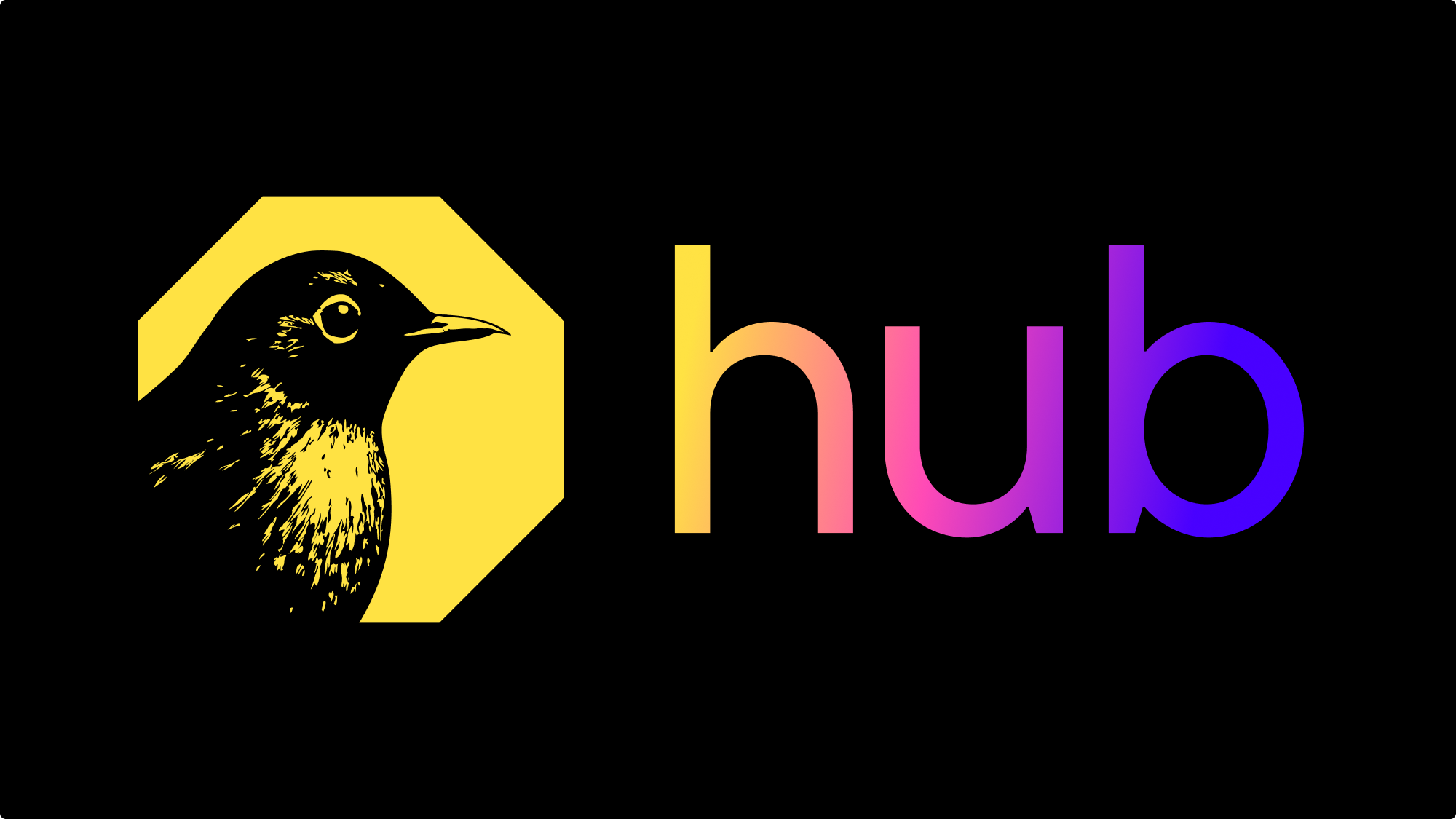Performance marketers need clear, reliable data to scale campaigns and prove ROI. Yet privacy updates and stricter tracking rules now block many of the signals that reveal which ads truly drive results, leaving ad spend harder to control and optimize.
Less visibility into user actions means less clarity on which campaigns are driving results and where budgets should go. A better approach is to use the data you collect directly from your users.
Built on top of Signals Gateway, Bïrch Hub collects these first-party events and sends them to Meta through a secure server you control, keeping attribution accurate even when browser tracking is limited.
Getting first party data via server-side tracking is an essential component of today’s marketing stack. In this guide, find out how you can use it to regain insight, improve attribution, and get more from your ad spend—with Bïrch Hub providing a simple way to set up and manage everything in one place.
Key takeaways
- Privacy changes and cookie restrictions have reduced the quality of tracking data for marketers.
- With Bïrch Hub, you can capture first-party data from your own systems and send it to Meta’s ad ecosystem for more accurate attribution.
- Signals Gateway sends events in real time, making attribution and campaign optimization faster.
- Bïrch Hub provides a managed setup that eliminates the need for technical maintenance while ensuring data quality.
Why marketers are losing visibility
Many browsers now block third-party cookies by default, making it harder to track people across different websites.
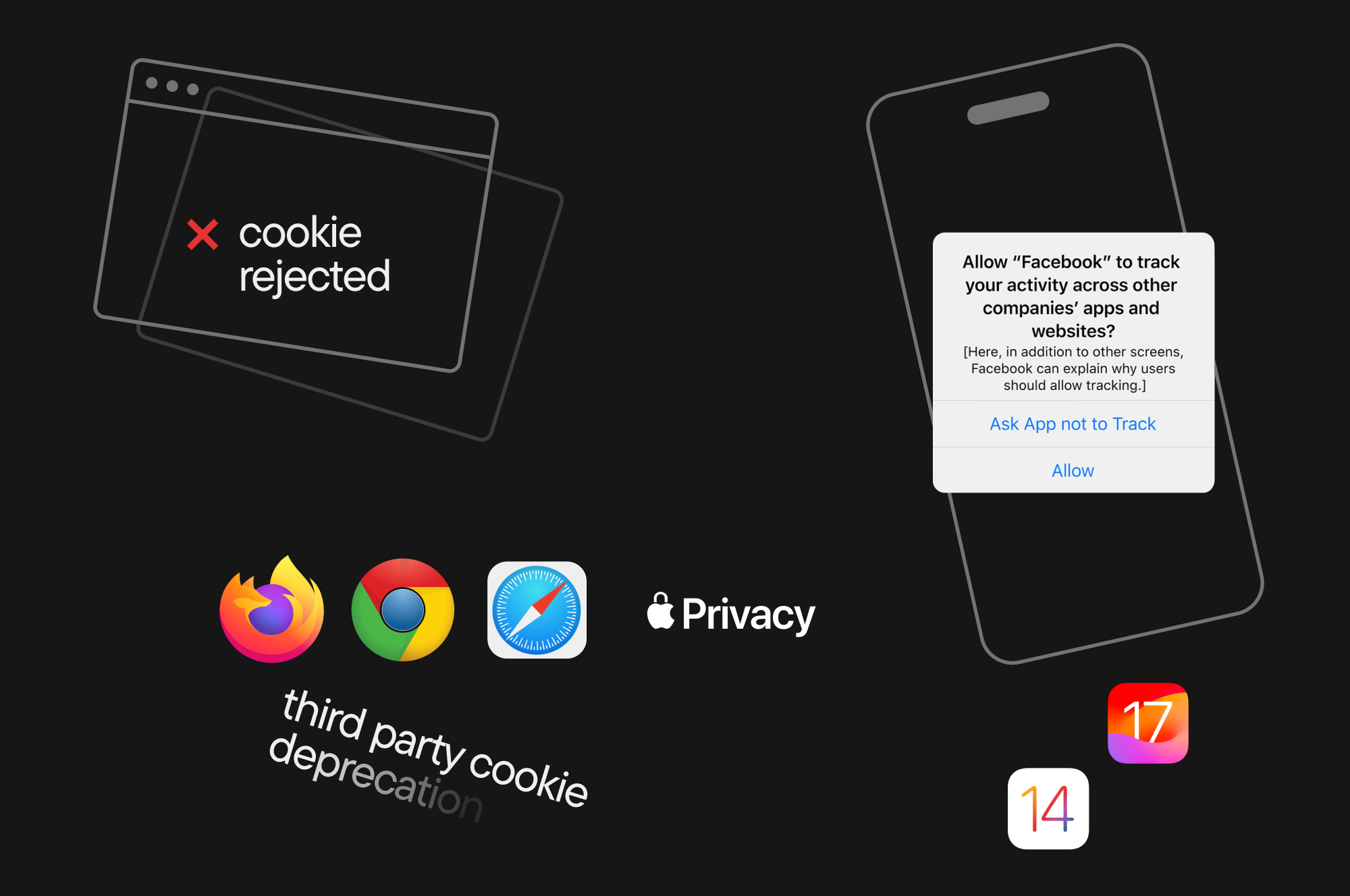
Privacy laws such as GDPR and CCPA add another layer. They restrict how personal information can be stored or shared for ad targeting and force stricter consent management, which often means less data makes it back to ad platforms.
Standard pixels often miss critical site actions, especially as browsers block third-party tracking. When those events never reach Meta, reporting becomes incomplete and optimization suffers. Without a stronger first-party setup, you can’t be sure every click, form submission, or purchase is counted.
What Bïrch Hub actually does
Bïrch Hub gives marketers a way to pass cleaner, more complete event data to Meta. It works alongside Meta’s Conversions API to improve event quality through deduplication and routing. It also offers more flexibility than most server-side setups, letting you send this data to analytics or storage tools for deeper insights.
How it works with Meta’s Conversions API
Meta’s Conversions API Gateway is a server-side setup that sends event data, like purchases or sign-ups, directly to Meta. It helps improve tracking accuracy, especially when browser or device privacy settings limit what can be captured through traditional methods.
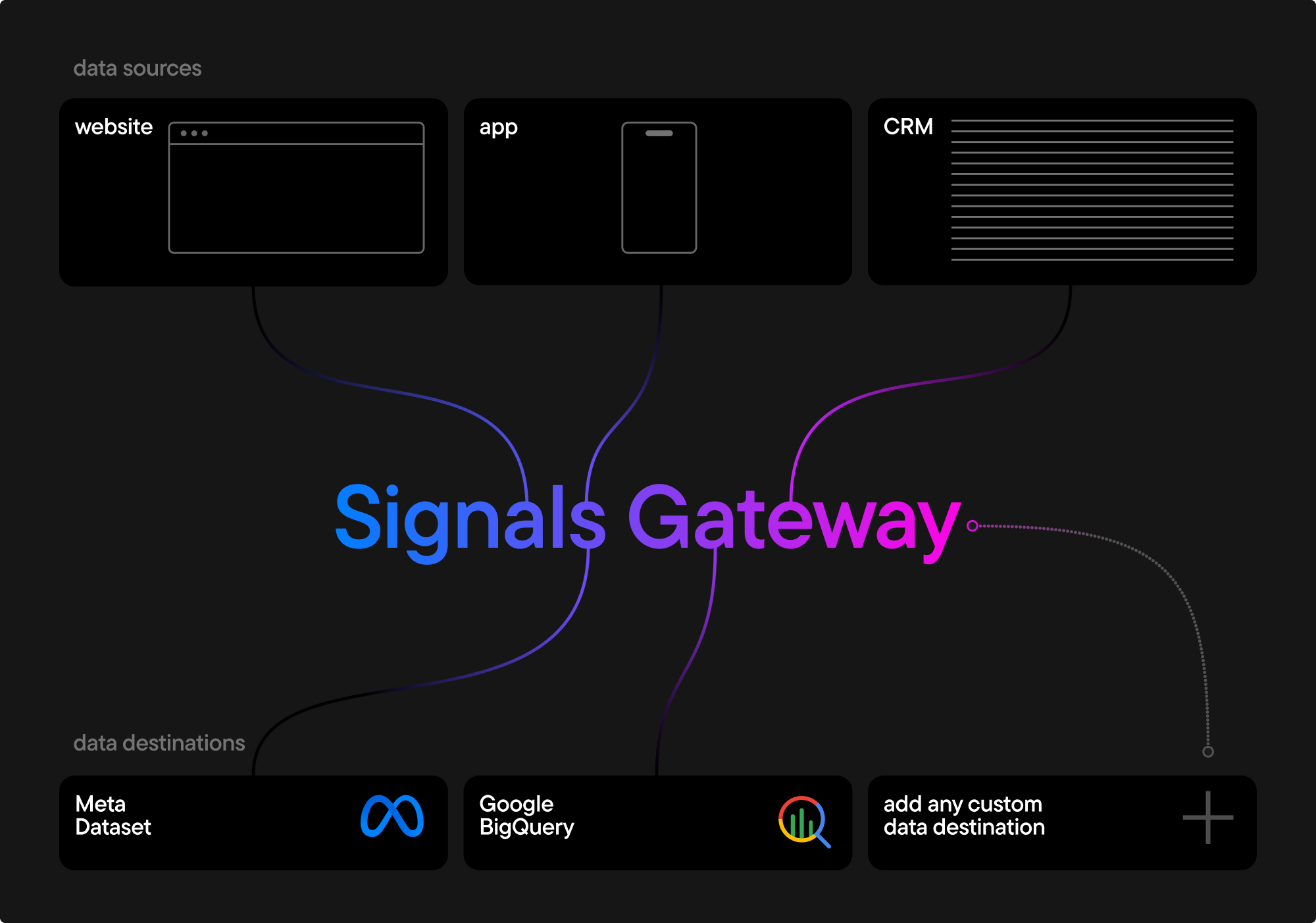
Built on top of Signals Gateway, Bïrch Hub acts as a central hub for multiple data sources. It collects, processes, and filters events before sending them to Meta through the Conversions API.
Event quality, deduplication, and data routing explained
Meta prioritizes high-quality events—those with complete details, consistent formatting, and no duplicates. Bïrch Hub processes and organizes event data before sending it to Meta, so what arrives is clean and reliable.
Many advertisers send the same event from the Meta Pixel (browser-based) and the Conversions API (server-based) to ensure nothing is missed. Meta can count that action twice, and that’s where deduplication comes in. Bïrch Hub automatically tags events, so Meta can match and keep just one record.
Data routing gives you additional control. You can send the same events to Meta without disrupting Meta’s tracking. This keeps all your campaigns aligned and makes reporting easier.
How Bïrch Hub differs from other server-side setups
Most server-side tracking setups are tied to one platform, limiting how you maintain or scale them. Bïrch Hub works within Meta’s ecosystem but uses a structure that allows simple configuration and routing flexibility. You’re not locked into a one-path setup, so it’s easier to adapt when campaign strategies or compliance needs change.
Mikhail Trofimov, CEO of Bïrch, explains why this deeper integration matters:
He also noted that businesses relying only on the standard pixel can lose about 30% to 40% of their ad efficiency—roughly $4,000 every month for a $10,000 ad budget—because valuable events never reach Meta’s system.
Winning seasonal and high-growth campaigns with first-party data
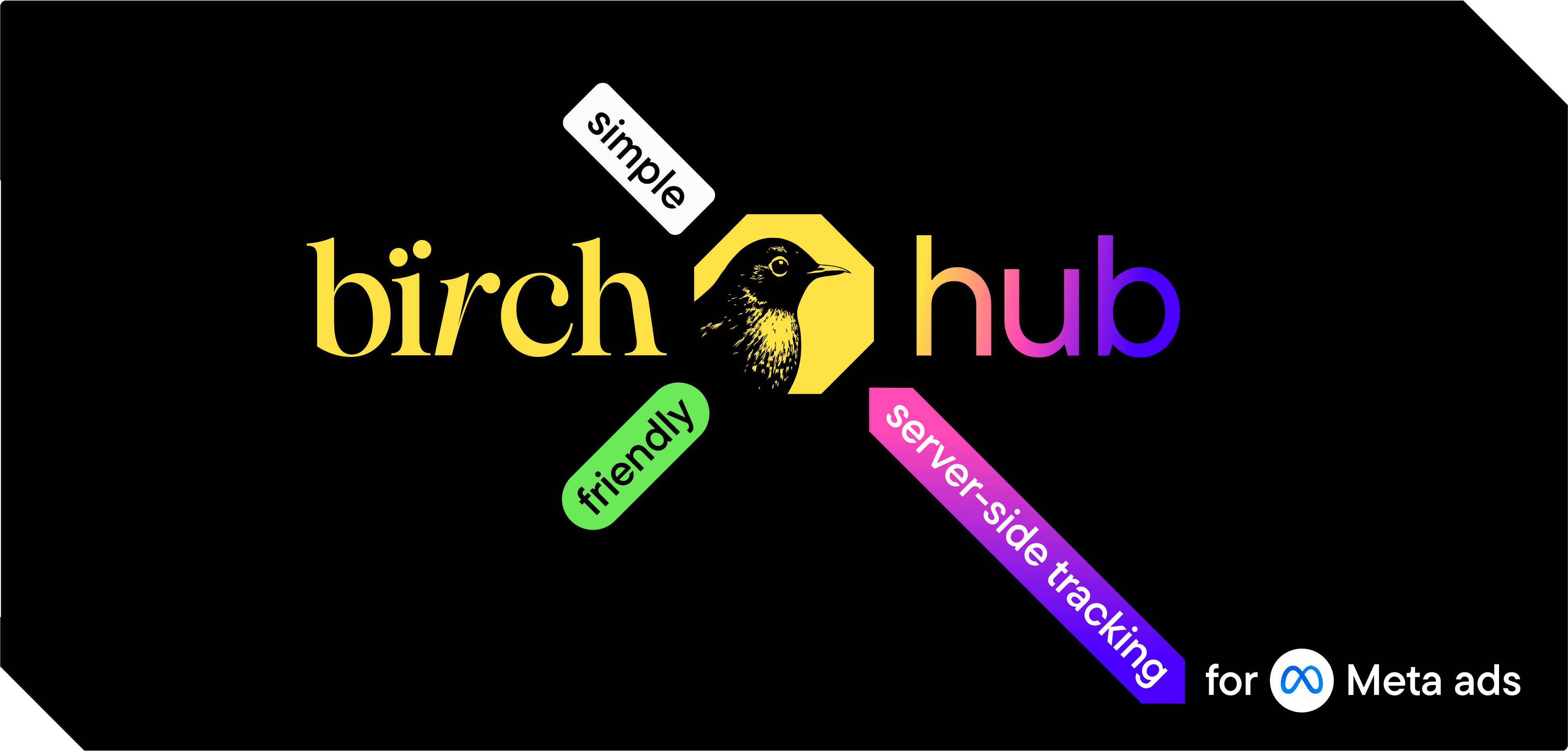
Real-time attribution and optimization
Web actions such as signing up for an account, starting a trial, or buying credits through a checkout page send immediate signals about which ads drive results. Bïrch Hub delivers these events to Meta the moment they happen.
With that live data, Meta can quickly shift budget and targeting toward audiences that engage and away from those that don’t. You stay focused on strategy instead of constantly adjusting campaigns.
This speed matters for high-growth or seasonal campaigns. Fast feedback lets you move budget to the best-performing ads while the opportunity is still open, keeping cost per install or action lower and driving more conversions before the window closes.
Audience building, suppression, and lifecycle campaign use
Better data means better targeting. With clearer insight into actions like purchases, subscriptions, or repeat visits, you can create precise audiences and exclude people who have already converted. This same data helps you guide users through onboarding, engagement, retention, or reactivation with ads tailored to each stage.
How to get started with server-side tracking
Setup depends on your technical resources and goals. Some teams choose to run server-side tracking entirely on their own infrastructure. Others use a managed service to speed up deployment and reduce maintenance work.
Self-hosting vs. managed setup
Self-hosting gives you full control but requires setting up and maintaining the infrastructure yourself:
- Server setup: Set up a secure cloud server (AWS, GCP, Azure, etc.) and connect it to your Meta Events Manager dataset.
- Domain connection: Add a CNAME record so the gateway runs on a subdomain you own, ensuring first-party tracking.
- Pixel and API configuration: Install the Signals Gateway pixel, enable the Conversions API, and align event names so browser and server events deduplicate correctly.
- Ongoing maintenance: Monitor performance, apply updates, and handle scaling as traffic grows.
A managed setup hosts the gateway for you. Instead of configuring servers and DNS records, you simply link your Meta account and drop the pixel into your site while the provider handles updates, scaling, and security.
Both options deliver first-party event tracking, but self-hosting means every technical step remains your responsibility, while a managed service handles the heavy lifting.
For example, CricksyDog, an e-commerce pet-food brand operating across eight European countries, chose a managed setup with Bïrch Hub. They created a dedicated gateway for each domain and saw a 40% increase in tracked events, a 30% drop in cost per action, and a 35% rise in conversions—showing how a managed service can unlock stronger data and ad performance without the infrastructure work.
First-party data tracking made simple with Bïrch Hub
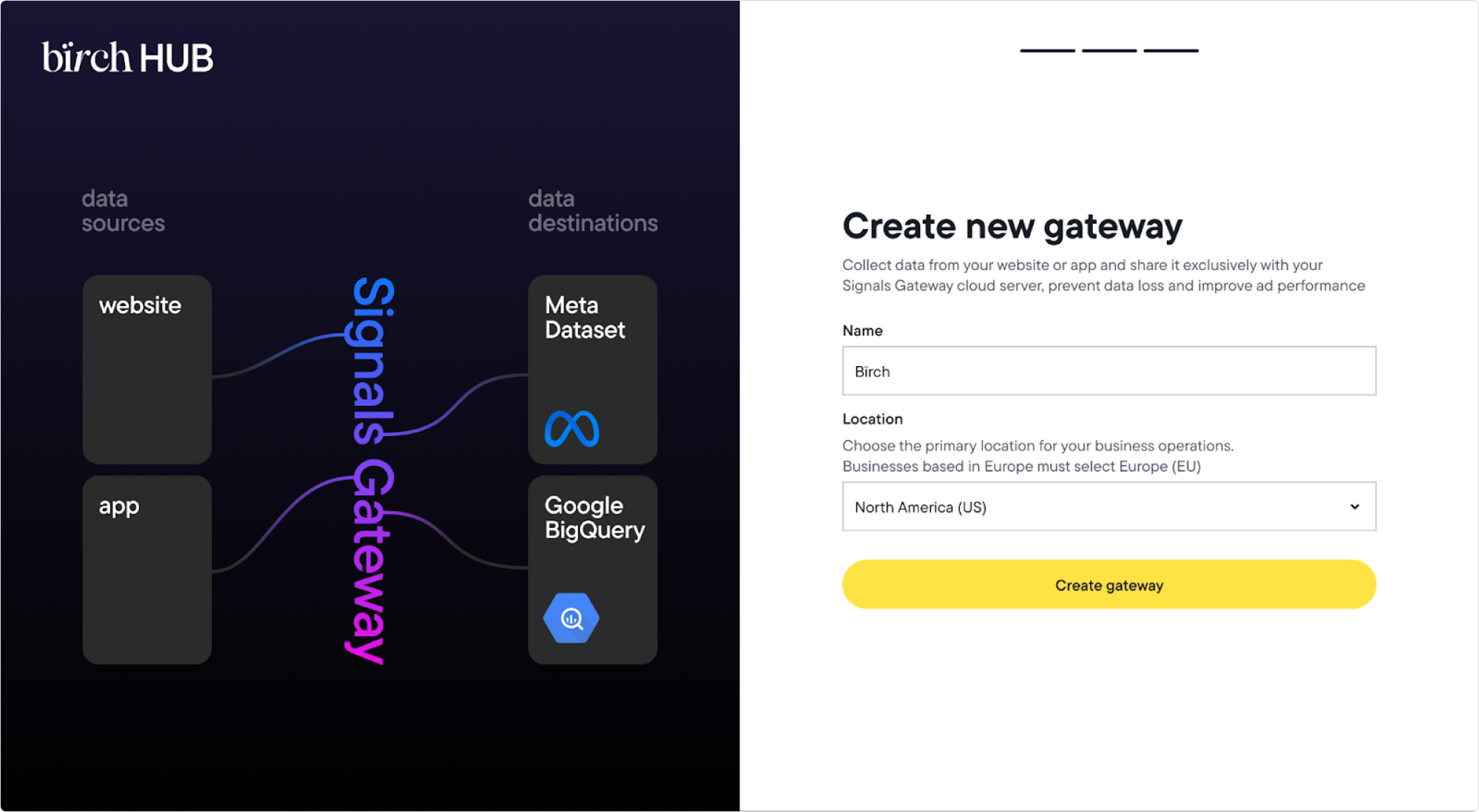
With Bïrch Hub, you can set everything up in one place:
- Connect your Meta account
- Choose the dataset for events
- Link your domain, so the server runs under your site
- Add the new pixel—your existing events start sending automatically
This first-party setup passes complete event data to Meta, keeping reports accurate and helping the algorithm optimize campaigns.
Looking ahead: preparing for the next wave of privacy changes
Privacy rules and platform policies will keep evolving, and tracking methods that work today may not work the same way in a year. Starting September 23, Snapchat, for example, will verify if your chosen optimization goals and conversion windows are actually supported by your pixel or app data. This means that if your data quality isn’t strong enough, the campaign won’t launch with that goal—preventing misconfigured campaigns and wasted spend. The best approach is to build an adaptable data foundation now.
Over the next few years, regulations around third-party cookies and other third-party data sources are expected to become even stricter. Meta will also likely require server-side tracking for conversion ads, so brands that delay the shift risk losing as much as 30–40% of ad efficiency.
How Bïrch Hub helps future-proof your stack
The setup runs on your infrastructure, so you control data collection. If browsers or ad networks introduce new limits, you can adjust your event setup. There’s no need to rely on a single platform’s tracking tools.
Cookie-consent rules may also become more standardized at the browser level, replacing today’s inconsistent pop-ups. A clear, centralized consent process would make privacy compliance easier for both users and advertisers, but it will still depend on strong first-party data.
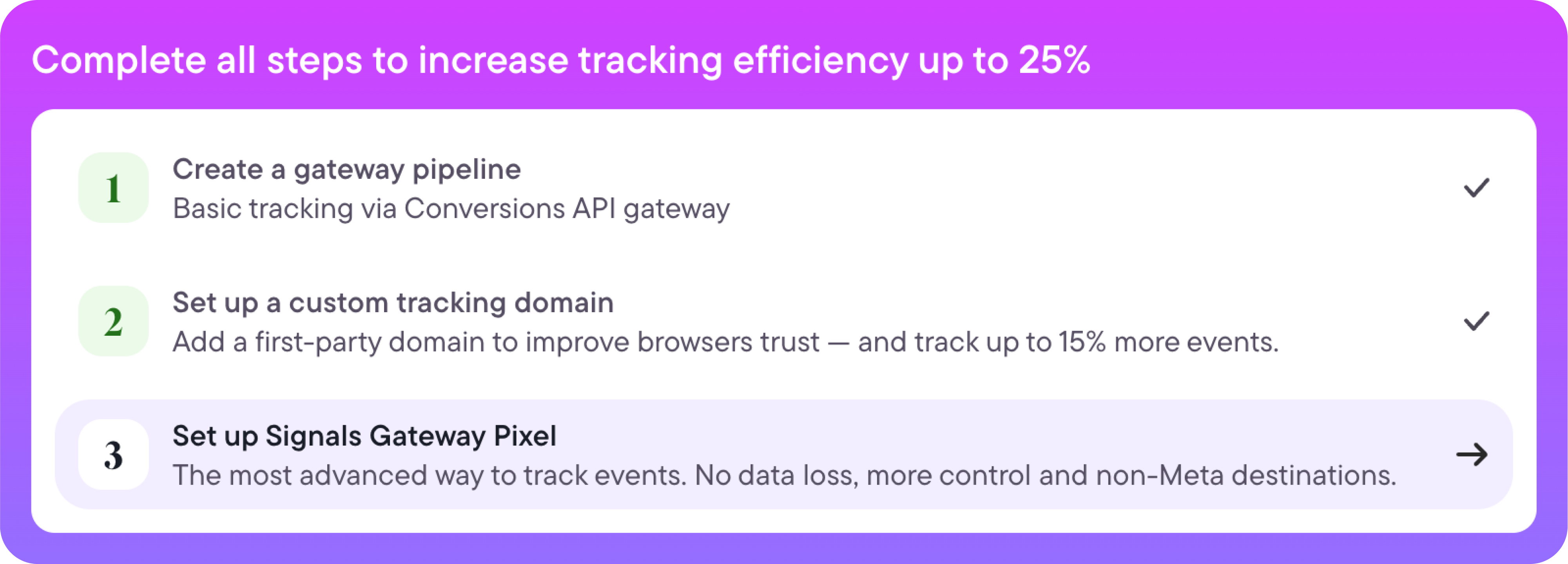
Bïrch Hub’s ability to route data to multiple destinations also means you can plug in new analytics or ad platforms without overhauling your tracking.
What marketers should do today to stay ahead
To prepare for ongoing privacy changes and keep your tracking reliable, focus on strengthening your data setup. Here’s how:
- Audit how your current web tracking works and look for gaps where events may be lost.
- Define the key events you want to track across the full user journey, from install to repeat purchase.
- Build or connect a first-party data setup that stores these events in your own environment.
- Put this in place as early as possible so you can adapt to privacy updates without losing visibility or campaign performance.
Take control of your campaign tracking
Privacy updates are disrupting how tracking works. Marketers need more reliable ways to capture and attribute events.
Bïrch Hub allows you to set up server-side tracking in just a few steps without managing servers or code. It hosts and routes your event data securely, so reporting stays accurate and Meta’s algorithm can fully optimize your campaigns.
FAQs
What is first-party data?
First-party data is information you collect directly from your audience through your own channels, like your website, CRM, or apps.
What’s the difference between first-party and third-party data?
First-party data is collected directly from your audience through channels you own, like your website, or CRM.
Third-party data comes from external sources that gather information from multiple sites or platforms.
Why is first-party data important?
First-party data is more reliable for long-term marketing. It’s accurate and privacy-compliant—plus, it doesn’t depend on third-party sources.
How can I collect first-party data?
Collect first-party data by tracking on-site behavior, using sign-up forms, running loyalty programs, sending surveys, or gathering purchase details (with user consent).
How can I use first-party data in marketing?
Analyze the data to understand your audience’s behavior and preferences, then apply those insights to personalize ads, segment email lists, adjust offers, and improve targeting across channels.
What happened to Revealbot?
Revealbot has a new look and a new name—we’re now Bïrch! The change highlights our focus on bringing together the best of automation and creative teamwork.
Performance marketers need clear, reliable data to scale campaigns and prove ROI. Yet privacy updates and stricter tracking rules now block many of the signals that reveal which ads truly drive results, leaving ad spend harder to control and optimize.
Less visibility into user actions means less clarity on which campaigns are driving results and where budgets should go. A better approach is to use the data you collect directly from your users.
Built on top of Signals Gateway, Bïrch Hub collects these first-party events and sends them to Meta through a secure server you control, keeping attribution accurate even when browser tracking is limited.
Getting first party data via server-side tracking is an essential component of today’s marketing stack. In this guide, find out how you can use it to regain insight, improve attribution, and get more from your ad spend—with Bïrch Hub providing a simple way to set up and manage everything in one place.
Key takeaways
- Privacy changes and cookie restrictions have reduced the quality of tracking data for marketers.
- With Bïrch Hub, you can capture first-party data from your own systems and send it to Meta’s ad ecosystem for more accurate attribution.
- Signals Gateway sends events in real time, making attribution and campaign optimization faster.
- Bïrch Hub provides a managed setup that eliminates the need for technical maintenance while ensuring data quality.
Why marketers are losing visibility
Many browsers now block third-party cookies by default, making it harder to track people across different websites.

Privacy laws such as GDPR and CCPA add another layer. They restrict how personal information can be stored or shared for ad targeting and force stricter consent management, which often means less data makes it back to ad platforms.
Standard pixels often miss critical site actions, especially as browsers block third-party tracking. When those events never reach Meta, reporting becomes incomplete and optimization suffers. Without a stronger first-party setup, you can’t be sure every click, form submission, or purchase is counted.
What Bïrch Hub actually does
Bïrch Hub gives marketers a way to pass cleaner, more complete event data to Meta. It works alongside Meta’s Conversions API to improve event quality through deduplication and routing. It also offers more flexibility than most server-side setups, letting you send this data to analytics or storage tools for deeper insights.
How it works with Meta’s Conversions API
Meta’s Conversions API Gateway is a server-side setup that sends event data, like purchases or sign-ups, directly to Meta. It helps improve tracking accuracy, especially when browser or device privacy settings limit what can be captured through traditional methods.

Built on top of Signals Gateway, Bïrch Hub acts as a central hub for multiple data sources. It collects, processes, and filters events before sending them to Meta through the Conversions API.
Event quality, deduplication, and data routing explained
Meta prioritizes high-quality events—those with complete details, consistent formatting, and no duplicates. Bïrch Hub processes and organizes event data before sending it to Meta, so what arrives is clean and reliable.
Many advertisers send the same event from the Meta Pixel (browser-based) and the Conversions API (server-based) to ensure nothing is missed. Meta can count that action twice, and that’s where deduplication comes in. Bïrch Hub automatically tags events, so Meta can match and keep just one record.
Data routing gives you additional control. You can send the same events to Meta without disrupting Meta’s tracking. This keeps all your campaigns aligned and makes reporting easier.
How Bïrch Hub differs from other server-side setups
Most server-side tracking setups are tied to one platform, limiting how you maintain or scale them. Bïrch Hub works within Meta’s ecosystem but uses a structure that allows simple configuration and routing flexibility. You’re not locked into a one-path setup, so it’s easier to adapt when campaign strategies or compliance needs change.
Mikhail Trofimov, CEO of Bïrch, explains why this deeper integration matters:
He also noted that businesses relying only on the standard pixel can lose about 30% to 40% of their ad efficiency—roughly $4,000 every month for a $10,000 ad budget—because valuable events never reach Meta’s system.
Winning seasonal and high-growth campaigns with first-party data

Real-time attribution and optimization
Web actions such as signing up for an account, starting a trial, or buying credits through a checkout page send immediate signals about which ads drive results. Bïrch Hub delivers these events to Meta the moment they happen.
With that live data, Meta can quickly shift budget and targeting toward audiences that engage and away from those that don’t. You stay focused on strategy instead of constantly adjusting campaigns.
This speed matters for high-growth or seasonal campaigns. Fast feedback lets you move budget to the best-performing ads while the opportunity is still open, keeping cost per install or action lower and driving more conversions before the window closes.
Audience building, suppression, and lifecycle campaign use
Better data means better targeting. With clearer insight into actions like purchases, subscriptions, or repeat visits, you can create precise audiences and exclude people who have already converted. This same data helps you guide users through onboarding, engagement, retention, or reactivation with ads tailored to each stage.
How to get started with server-side tracking
Setup depends on your technical resources and goals. Some teams choose to run server-side tracking entirely on their own infrastructure. Others use a managed service to speed up deployment and reduce maintenance work.
Self-hosting vs. managed setup
Self-hosting gives you full control but requires setting up and maintaining the infrastructure yourself:
- Server setup: Set up a secure cloud server (AWS, GCP, Azure, etc.) and connect it to your Meta Events Manager dataset.
- Domain connection: Add a CNAME record so the gateway runs on a subdomain you own, ensuring first-party tracking.
- Pixel and API configuration: Install the Signals Gateway pixel, enable the Conversions API, and align event names so browser and server events deduplicate correctly.
- Ongoing maintenance: Monitor performance, apply updates, and handle scaling as traffic grows.
A managed setup hosts the gateway for you. Instead of configuring servers and DNS records, you simply link your Meta account and drop the pixel into your site while the provider handles updates, scaling, and security.
Both options deliver first-party event tracking, but self-hosting means every technical step remains your responsibility, while a managed service handles the heavy lifting.
For example, CricksyDog, an e-commerce pet-food brand operating across eight European countries, chose a managed setup with Bïrch Hub. They created a dedicated gateway for each domain and saw a 40% increase in tracked events, a 30% drop in cost per action, and a 35% rise in conversions—showing how a managed service can unlock stronger data and ad performance without the infrastructure work.
First-party data tracking made simple with Bïrch Hub

With Bïrch Hub, you can set everything up in one place:
- Connect your Meta account
- Choose the dataset for events
- Link your domain, so the server runs under your site
- Add the new pixel—your existing events start sending automatically
This first-party setup passes complete event data to Meta, keeping reports accurate and helping the algorithm optimize campaigns.
Looking ahead: preparing for the next wave of privacy changes
Privacy rules and platform policies will keep evolving, and tracking methods that work today may not work the same way in a year. Starting September 23, Snapchat, for example, will verify if your chosen optimization goals and conversion windows are actually supported by your pixel or app data. This means that if your data quality isn’t strong enough, the campaign won’t launch with that goal—preventing misconfigured campaigns and wasted spend. The best approach is to build an adaptable data foundation now.
Over the next few years, regulations around third-party cookies and other third-party data sources are expected to become even stricter. Meta will also likely require server-side tracking for conversion ads, so brands that delay the shift risk losing as much as 30–40% of ad efficiency.
How Bïrch Hub helps future-proof your stack
The setup runs on your infrastructure, so you control data collection. If browsers or ad networks introduce new limits, you can adjust your event setup. There’s no need to rely on a single platform’s tracking tools.
Cookie-consent rules may also become more standardized at the browser level, replacing today’s inconsistent pop-ups. A clear, centralized consent process would make privacy compliance easier for both users and advertisers, but it will still depend on strong first-party data.

Bïrch Hub’s ability to route data to multiple destinations also means you can plug in new analytics or ad platforms without overhauling your tracking.
What marketers should do today to stay ahead
To prepare for ongoing privacy changes and keep your tracking reliable, focus on strengthening your data setup. Here’s how:
- Audit how your current web tracking works and look for gaps where events may be lost.
- Define the key events you want to track across the full user journey, from install to repeat purchase.
- Build or connect a first-party data setup that stores these events in your own environment.
- Put this in place as early as possible so you can adapt to privacy updates without losing visibility or campaign performance.
Take control of your campaign tracking
Privacy updates are disrupting how tracking works. Marketers need more reliable ways to capture and attribute events.
Bïrch Hub allows you to set up server-side tracking in just a few steps without managing servers or code. It hosts and routes your event data securely, so reporting stays accurate and Meta’s algorithm can fully optimize your campaigns.
FAQs
What is first-party data?
First-party data is information you collect directly from your audience through your own channels, like your website, CRM, or apps.
What’s the difference between first-party and third-party data?
First-party data is collected directly from your audience through channels you own, like your website, or CRM.
Third-party data comes from external sources that gather information from multiple sites or platforms.
Why is first-party data important?
First-party data is more reliable for long-term marketing. It’s accurate and privacy-compliant—plus, it doesn’t depend on third-party sources.
How can I collect first-party data?
Collect first-party data by tracking on-site behavior, using sign-up forms, running loyalty programs, sending surveys, or gathering purchase details (with user consent).
How can I use first-party data in marketing?
Analyze the data to understand your audience’s behavior and preferences, then apply those insights to personalize ads, segment email lists, adjust offers, and improve targeting across channels.
What happened to Revealbot?
Revealbot has a new look and a new name—we’re now Bïrch! The change highlights our focus on bringing together the best of automation and creative teamwork.











